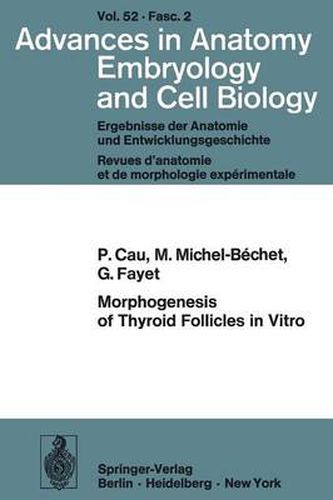Readings Newsletter
Become a Readings Member to make your shopping experience even easier.
Sign in or sign up for free!
You’re not far away from qualifying for FREE standard shipping within Australia
You’ve qualified for FREE standard shipping within Australia
The cart is loading…






This title is printed to order. This book may have been self-published. If so, we cannot guarantee the quality of the content. In the main most books will have gone through the editing process however some may not. We therefore suggest that you be aware of this before ordering this book. If in doubt check either the author or publisher’s details as we are unable to accept any returns unless they are faulty. Please contact us if you have any questions.
The thyroid gland first appears in the phylogenic scale in the Lamprey larva, Ammocoetes, at the time of metamorphosis (see review by Constantinescu, 1972). In higher Vertebrates the adult thyroid gland consists of vesicles i. e. thyroid follicles containing colloid and lined with a cubic or prismatic epithelium. Since the end of the 19th century, many authors have studied the morphoge nesis of the follicles during the embryonic and fetal development of the gland in Man and other species, principally Chick, Rat and Rabbit. The development of techniques for culturing organs of higher animals, in particular the thyroid by Carrel and Burrows (1910) and Champy (1914, 1915), allowed the study of the survival in vivo or in vitro of grafts or explants of thyroid gland obtained from adult or fetal animals. In addition to organotypic cultures, techniques for culturing cell suspensions obtained by enzymatic dissociation have recently been refined. Moreover, histological examination of pathological human glands and adult thyroids experimentally stimulated by thyrotropin hormone (TSH) has provided additional data for the understanding of thyroid follicle morphogenesis.
$9.00 standard shipping within Australia
FREE standard shipping within Australia for orders over $100.00
Express & International shipping calculated at checkout
This title is printed to order. This book may have been self-published. If so, we cannot guarantee the quality of the content. In the main most books will have gone through the editing process however some may not. We therefore suggest that you be aware of this before ordering this book. If in doubt check either the author or publisher’s details as we are unable to accept any returns unless they are faulty. Please contact us if you have any questions.
The thyroid gland first appears in the phylogenic scale in the Lamprey larva, Ammocoetes, at the time of metamorphosis (see review by Constantinescu, 1972). In higher Vertebrates the adult thyroid gland consists of vesicles i. e. thyroid follicles containing colloid and lined with a cubic or prismatic epithelium. Since the end of the 19th century, many authors have studied the morphoge nesis of the follicles during the embryonic and fetal development of the gland in Man and other species, principally Chick, Rat and Rabbit. The development of techniques for culturing organs of higher animals, in particular the thyroid by Carrel and Burrows (1910) and Champy (1914, 1915), allowed the study of the survival in vivo or in vitro of grafts or explants of thyroid gland obtained from adult or fetal animals. In addition to organotypic cultures, techniques for culturing cell suspensions obtained by enzymatic dissociation have recently been refined. Moreover, histological examination of pathological human glands and adult thyroids experimentally stimulated by thyrotropin hormone (TSH) has provided additional data for the understanding of thyroid follicle morphogenesis.